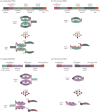Cyclic nucleotide signalling in malaria parasites
- PMID: 29263246
- PMCID: PMC5746546
- DOI: 10.1098/rsob.170213
Cyclic nucleotide signalling in malaria parasites
Abstract
The cyclic nucleotides 3', 5'-cyclic adenosine monophosphate (cAMP) and 3', 5'-cyclic guanosine monophosphate (cGMP) are intracellular messengers found in most animal cell types. They usually mediate an extracellular stimulus to drive a change in cell function through activation of their respective cyclic nucleotide-dependent protein kinases, PKA and PKG. The enzymatic components of the malaria parasite cyclic nucleotide signalling pathways have been identified, and the genetic and biochemical studies of these enzymes carried out to date are reviewed herein. What has become very clear is that cyclic nucleotides play vital roles in controlling every stage of the complex malaria parasite life cycle. Our understanding of the involvement of cyclic nucleotide signalling in orchestrating the complex biology of malaria parasites is still in its infancy, but the recent advances in our genetic tools and the increasing interest in signalling will deliver more rapid progress in the coming years.
Keywords: Plasmodium; anopheles; cyclase; cyclic nucleotides; malaria parasites; phosphodiesterase.
© 2017 The Authors.
Conflict of interest statement
We declare we have no competing interests.
Figures




References
-
- World Health Organization. 2016. World malaria report 2016 Geneva, Switzerland: World Health Organization.
-
- Burrows JN, Duparc S, Gutteridge WE, Hooft van Huijsduijnen R, Kaszubska W, Macintyre F, Mazzuri S, Möhrle JJ, Wells TNC. 2017. New developments in anti-malarial target candidate and product profiles. Malar. J. 16, 26 (doi:10.1186/s12936-016-1675-x) - DOI - PMC - PubMed
-
- Schaap P. 2016. Evolution of developmental signalling in dictyostelid social amoebas. Curr. Opin. Genet. Dev. 39, 29–34. (doi:10.1016/j.gde.2016.05.014) - DOI - PMC - PubMed
-
- Linder JU, Engel P, Reimer A, Krüger T, Plattner H, Schultz A, Schultz JE. 1999. Guanylyl cyclases with the topology of mammalian adenylyl cyclases and an N-terminal P-type ATPase-like domain in Paramecium, Tetrahymena and Plasmodium. EMBO J. 18, 4222–4232. (doi:10.1093/emboj/18.15.4222) - DOI - PMC - PubMed
-
- Dawn A, Singh S, More KR, Siddiqui FA, Pachikara N, Ramdani G, Langsley G, Chitnis CE. 2014. The central role of cAMP in regulating Plasmodium falciparum merozoite invasion of human erythrocytes. PLoS Pathog. 10, e1004520 (doi:10.1371/journal.ppat.1004520) - DOI - PMC - PubMed
Publication types
MeSH terms
Substances
Grants and funding
LinkOut - more resources
Full Text Sources
Other Literature Sources

